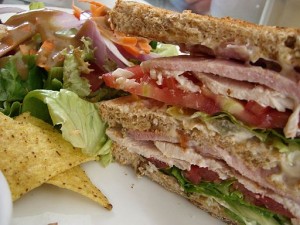Top Mistakes That Students of Norwegian Make
Norwegian is said to be one of the easiest languages for English speakers to learn, which means it must be without pitfalls, right? Wrong! As with any second language, there are trips and stumbles to be made along the way. Just know that you’re in good company: here are the top most common mistakes that students of Norwegian make.
1. Making a verb sandwich with modals by adding å where it’s not needed
Ah, modal verbs, those tricky little things that stick a metaphorical foot out and send you tumbling to the floor in many a language. In English, modals are never to be followed by to, and in Norwegian, the offending word is å. In sentences that require two verbs, if the first verb is a modal - kan, vil, skal, må, bør (can, want, will, must, and should) - it must never be followed by å. Jeg kan kaste ballen instead ofjeg kan å kaste ballen (I can throw the ball).
 No, not that kind of sandwich…via Wikimedia / Wikimedia
No, not that kind of sandwich…via Wikimedia / Wikimedia
2. The letter U and Y often get mixed up
Y serves as a semi-vowel in English but always as a full noun in Norwegian, which is a stumbling block in itself. Couple that with mixing up the u sound with the y sound, and you are in for a tongue twister indeed. U is more like the o in who, whereas Y is more like the ee in cheese. So ute is ‘out’, when pronounced correctly, not yte (‘provide’) when it isn’t.
3. Identify a non-native with the dipthong KJ
The kj sound is said to be near impossible to master. Some say it sounds like an h in house, others like ch in checkers, and even the Norwegians themselves often pronounce it as sh in shoe. The closest approximation to correct you can get is probably the original h. Have a little practice with the word kjøkken (‘kitchen’) if you’re feeling brave.
4. Using to to travel through time
In English we use going to to describe a future event as well as to talk about a place we are travelling to. It follows therefore that a new Norwegian language learner might also use å gå - ‘to go’ - in a similar fashion. However, this translates directly as ‘to walk’. If you want to specifically talk about travelling, you need to use å reise instead.
 Image via Wikipedia
Image via Wikipedia
5. Mistaking den or det for the
The does not appear as a separate den or det in Norwegian, even if it is instinctual for English speakers to do just that. Like other Scandinavian languages, to make an article definite - the house or the chair - the suffix et (huset) or en (stolen) must be used.
6. Making every sentence into a poem
This might be one of the smaller mistakes made by students of Norwegian, but it is a pretty direct language. Verbs are used in a specific structure in sentences. Generally speaking, verbs should either be the first word of a sentence if it is a question, or the second word if it is a normal sentence. If used elsewhere, verbs make sentences seem cumbersome and too old-fashioned. Jeg drikker kaffe om morgenen - I drink coffee in the morning - shows a typical Norwegian sentence structure.
7. Many ways to think
Often the English language is accused of having many homonyms, and often that is true. Don’t let that lead you into a trap in Norwegian. The word think in English can be used to identify something you know, something you believe, and the process of thinking itself. This is not true in Norwegian, since there are specific words for each:
- å tro is used for something you believe
- å synes is used for something that you know
- å tenke på noe is the process of thinking
8. A short, sharp thank you will suffice
Takk - thank you - is possibly the most recogniseable Norwegian word; after all, it is a cognate. However, if you lengthen the sound of the work takk to make it sound more like ‘taaaak’, this has another meaning entirely. When pronouncing this particular tak, you are talking about the roof of a house, and will probably be met with confusion if all you’re trying to say is thanks.
9. An invitation to drink
Our final mistake that students of Norwegian make is a little tongue in cheek and a lot potential fun. Confusing the questions påfyll? - do you want a refill? with på fylla? - do you want to get drunk? could lead to all sorts of (mis)adventures, so (mis)use them with care!
Learning Norwegian is not without its pitfalls, but it’s good to know that you’re in the same boat with other learners out there making similar mistakes. Of course, learning any language is a task that should be approached from many angles, from self-study to group practice. Do you want some help with your studies? Contact us now to see what we have available to suit your needs.



